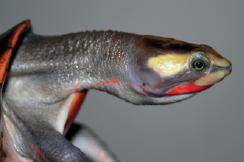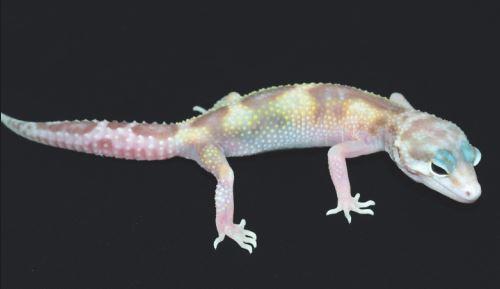
The Leopard Gecko,Eublepharis macularius, has been bred so long and successfully in the terrarium that the majority of younger terrarium keepers (ie people under 30) have never seen a wild-caught one with their own eyes. There are even specialist breeders that produce designer Leopard Geckos for the wholesale trade, just as there are breeders of ornamental fishes. The photos that illustrate this article show the latest cultivated forms of this lovely lizard.
The Leopard Gecko is without doubt one of the easiest lizards to maintain in the terrarium. This is because it originally came from the inhospitable stony wastes of Pakistan, parts of Afghanistan and India, and Iran, where these geckos have to be able to endure drought, heat, and cold and the food supply isn’t too abundant either. As a result these geckos are undemanding in the terrarium. The basic décor should be a substrate of soft, dust-free sand around 10 cm deep, with an admixture of around 10-15% loam, and a daytime hiding-place in the form of a horizontally positioned, hollow piece of cork bark. In addition there should be a box for egg-laying (see “Breeding”). And that is all these lizards require. Of course that doesn’t mean that their owner can’t set up an attractive terrarium, as long as he is under no illusion that he is doing it for himself rather than the geckos.
Beware of avalanches!
If you are going to simulate a stony waste using rocks, then it is essential to make sure the structure is robust and stable. These geckos are astonishingly strong. If the rockwork collapses then this may lead not only to breakage of the terrarium but also to serious harm to the geckos. It is also important to make sure that the terrarium doesn’t have too many nooks and crannies where food insects can creep away and hide. It can be quite a nuisance when a male cricket sings his serenade all night long or when zophobas and mealworms devour the eggs of the geckos. Because Leopard Geckos usually select a particular spot in the terrarium as their toilet, cleaning is very little work and takes next to no time.
Equipment
During the day a heat lamp should be used to provide an air temperature of 25-26°C, while immediately beneath the lamp it should be around 30°C. The lighting should be on for around 14 hours, and at night the temperature should drop to 20-21°C, which should happen automatically in normal living-rooms when the lamp is switched off. Even though Leopard Geckos are predominantly nocturnal and – as dozens of generations of captive-bred individuals demonstrate – can get by completely without UV light, it is nevertheless advisable to choose a heat lamp that also has a mild UV component, as it seems that UV light has a psychological as well as a physiological effect in reptiles. Many individuals quite simply feel better with UV light.

Water – a vexed question
In the wild these geckos only very rarely come across puddles or the like from which to drink. Instead they mainly use the morning dew to satisfy their water requirement, which is in any case low and largely supplied by their food. In the terrarium too they greatly enjoy the tank being sprayed briefly in the morning and drink the water in drop form. It is important that the amount of spray is calculated such that the terrarium is completely dry again within around an hour at the latest. Leopard Geckos do, however, also like to drink from water bowls. The only problem with these is that they rapidly become dirty, and dirty water is more dangerous than no water at all. So if you want to provide a water bowl then you should do so only for 2-3 hours during the period when the geckos are active and then remove it from the terrarium again. The relative humidity in the terrarium should be about 40% during the day and rise to up to 80% at night. Leopard Geckos don’t bathe. If they are kept too dry for long periods then this can lead to molting problems, in particular affecting the toes. For this reason there should always be a box for egg-laying in the terrarium, even if you have no desire to breed (see below). This slightly (!) damp spot will be sought out by the Leopard Geckos if things get too dry for them.

Breeding
Leopard Gecko males are extremely territorial and won’t tolerate a second male in the vicinity. The sexes are fairly easy to distinguish. Males have clearly visible hemipenis sacs that can be seen as distinct protrusions on either side of the base of the tail. In addition they have large pre-anal pores and are generally more heavily-built than females. The comparatively broad skull of the male is very distinctive. Depending on the size of the terrarium, Leopard Geckos can be kept as a pair or a male with up to four females. The ladies are well behaved among themselves. Leopard Geckos are totally carnivorous and will take the usual food insects (crickets, grasshoppers, mealworms, zophobas), which should always be dusted with a calcium and vitamin mixture. Because Leopard Geckos become very tame they will often take food from forceps.

The female lays her soft-shelled eggs around six weeks after mating, which can be stimulated by a rest phase of around 3 months at 15-18°C and a photoperiod of only 8 hours (though it will happen without this treatment). So that the eggs aren’t buried in the normal sand of the terrarium, where they can become dehydrated, the terrarium should be provided with a plastic box for egg-laying.This should contain around 10 cm of moist potting compost or similar and topped with a piece of bark.

You can also use a box with a lid and cut an entrance hole for the geckos in the lid. The box should be somewhat longer than the largest gecko, with a suitable size being 25 x 15 x 15 cm, for example, though these dimensions don’t have to be exact and are just a rough guideline.If the container is readily accessible the female will lay her eggs there, and they can then be dug up (take care, the eggs mustn’t be turned in the process) and transferred to a suitable incubation substrate (Vermiculite, Seramis, or similar) in an incubator, where they should be kept at 24-32 °C. In Leopard Geckos sex is determined by the incubation temperature. At 25-27°C almost 100% females hatch (after 70-90 days), at 31-32°C almost 100% males (after 35-40 days).

The ideal is an incubation temperature of 27-28 °C, where the eggs will take 50-70 days to hatch and will usually produce around 75% females and 25% males among the young.The youngsters are around 8 cm long on hatching and striped – in the wild form. In the designer geckos it depends very much on the strain with which you are working, as some characters are genetically dominant and thus immediately apparent in juveniles, while others are recessive (= hidden). In the latter case it is impossible to tell what characters the geckos will pass on to their offspring. So you need to be familiar with the Mendellian rules if you want to get involved in the demanding task of breeding color strains of the Leopard Gecko.

If you are now filled with the desire to keep Leopard Geckos,then your pet dealer can undoubtedly order them for you from a wholesaler of his acquaintance, for example Tropenparadies in Oberhausen.
Anzeige






